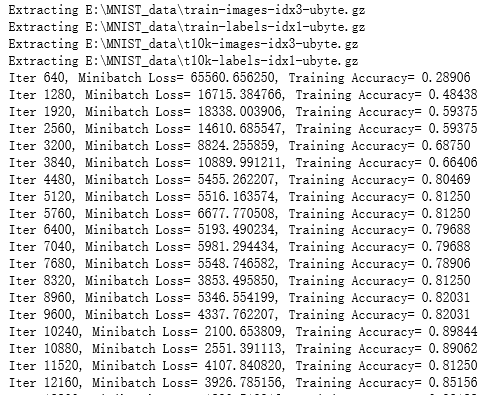import tensorflow as tf# 输入数据from tensorflow.examples.tutorials.mnist import input_datamnist = input_data.read_data_sets("E:\\MNIST_data", one_hot=True)# 定义网络的超参数learning_rate = 0.001training_iters = 200000batch_size = 128display_step = 5# 定义网络的参数# 输入的维度 (img shape: 28*28)n_input = 784 # 标记的维度 (0-9 digits)n_classes = 10 # Dropout的概率,输出的可能性dropout = 0.75 # 输入占位符x = tf.placeholder(tf.float32, [None, n_input])y = tf.placeholder(tf.float32, [None, n_classes])#dropout (keep probability)keep_prob = tf.placeholder(tf.float32) # 定义卷积操作def conv2d(name,x, W, b, strides=1): # Conv2D wrapper, with bias and relu activation x = tf.nn.conv2d(x, W, strides=[1, strides, strides, 1], padding='SAME') x = tf.nn.bias_add(x, b) # 使用relu激活函数 return tf.nn.relu(x,name=name) # 定义池化层操作def maxpool2d(name,x, k=2): # MaxPool2D wrapper return tf.nn.max_pool(x, ksize=[1, k, k, 1], strides=[1, k, k, 1],padding='SAME',name=name)# 规范化操作def norm(name, l_input, lsize=4): return tf.nn.lrn(l_input, lsize, bias=1.0, alpha=0.001 / 9.0,beta=0.75, name=name)# 定义所有的网络参数weights = { 'wc1': tf.Variable(tf.random_normal([11, 11, 1, 96])), 'wc2': tf.Variable(tf.random_normal([5, 5, 96, 256])), 'wc3': tf.Variable(tf.random_normal([3, 3, 256, 384])), 'wc4': tf.Variable(tf.random_normal([3, 3, 384, 384])), 'wc5': tf.Variable(tf.random_normal([3, 3, 384, 256])), 'wd1': tf.Variable(tf.random_normal([4*4*256, 4096])), 'wd2': tf.Variable(tf.random_normal([4096, 1024])), 'out': tf.Variable(tf.random_normal([1024, n_classes]))}biases = { 'bc1': tf.Variable(tf.random_normal([96])), 'bc2': tf.Variable(tf.random_normal([256])), 'bc3': tf.Variable(tf.random_normal([384])), 'bc4': tf.Variable(tf.random_normal([384])), 'bc5': tf.Variable(tf.random_normal([256])), 'bd1': tf.Variable(tf.random_normal([4096])), 'bd2': tf.Variable(tf.random_normal([1024])), 'out': tf.Variable(tf.random_normal([n_classes]))}# 定义整个网络def alex_net(x, weights, biases, dropout): # 向量转为矩阵 Reshape input picture x = tf.reshape(x, shape=[-1, 28, 28, 1]) # 第一层卷积 # 卷积 conv1 = conv2d('conv1', x, weights['wc1'], biases['bc1']) # 下采样 pool1 = maxpool2d('pool1', conv1, k=2) # 规范化 norm1 = norm('norm1', pool1, lsize=4) # 第二层卷积 # 卷积 conv2 = conv2d('conv2', norm1, weights['wc2'], biases['bc2']) # 最大池化(向下采样) pool2 = maxpool2d('pool2', conv2, k=2) # 规范化 norm2 = norm('norm2', pool2, lsize=4) # 第三层卷积 # 卷积 conv3 = conv2d('conv3', norm2, weights['wc3'], biases['bc3']) # 规范化 norm3 = norm('norm3', conv3, lsize=4) # 第四层卷积 conv4 = conv2d('conv4', norm3, weights['wc4'], biases['bc4']) # 第五层卷积 conv5 = conv2d('conv5', conv4, weights['wc5'], biases['bc5']) # 最大池化(向下采样) pool5 = maxpool2d('pool5', conv5, k=2) # 规范化 norm5 = norm('norm5', pool5, lsize=4) # 全连接层1 fc1 = tf.reshape(norm5, [-1, weights['wd1'].get_shape().as_list()[0]]) fc1 =tf.add(tf.matmul(fc1, weights['wd1']),biases['bd1']) fc1 = tf.nn.relu(fc1) # dropout fc1=tf.nn.dropout(fc1,dropout) # 全连接层2 fc2 = tf.reshape(fc1, [-1, weights['wd2'].get_shape().as_list()[0]]) fc2 =tf.add(tf.matmul(fc2, weights['wd2']),biases['bd2']) fc2 = tf.nn.relu(fc2) # dropout fc2=tf.nn.dropout(fc2,dropout) # 输出层 out = tf.add(tf.matmul(fc2, weights['out']) ,biases['out']) return out# 构建模型pred = alex_net(x, weights, biases, keep_prob)# 定义损失函数和优化器cost = tf.reduce_mean(tf.nn.softmax_cross_entropy_with_logits(logits=pred, labels=y))optimizer = tf.train.AdamOptimizer(learning_rate=learning_rate).minimize(cost)# 评估函数correct_pred = tf.equal(tf.argmax(pred,1), tf.argmax(y,1))accuracy = tf.reduce_mean(tf.cast(correct_pred, tf.float32))# 初始化变量init = tf.global_variables_initializer()# 开启一个训练with tf.Session() as sess: sess.run(init) step = 1 # 开始训练,直到达到training_iters,即200000 while step * batch_size < training_iters: #获取批量数据 batch_x, batch_y = mnist.train.next_batch(batch_size) sess.run(optimizer, feed_dict={x: batch_x, y: batch_y, keep_prob: dropout}) if step % display_step == 0: # 计算损失值和准确度,输出 loss,acc = sess.run([cost,accuracy], feed_dict={x: batch_x, y: batch_y, keep_prob: 1.}) print ("Iter " + str(step*batch_size) + ", Minibatch Loss= " + "{:.6f}".format(loss) + ", Training Accuracy= " + "{:.5f}".format(acc)) step += 1 print ("Optimization Finished!") # 计算测试集的精确度 print ("Testing Accuracy:",sess.run(accuracy, feed_dict={x: mnist.test.images[:256],y: mnist.test.labels[:256],keep_prob: 1.})) 